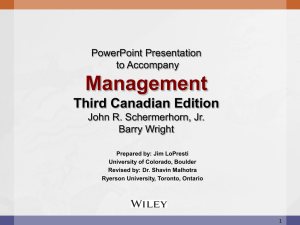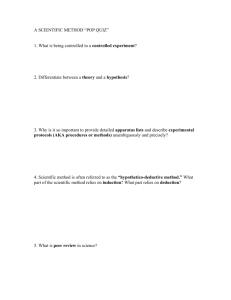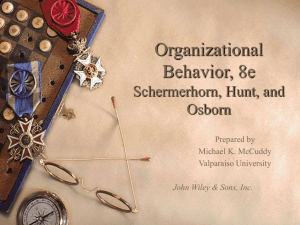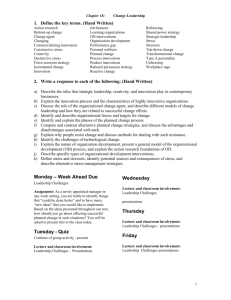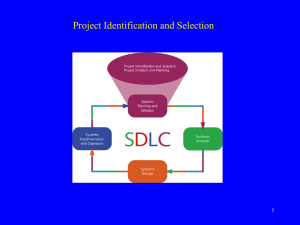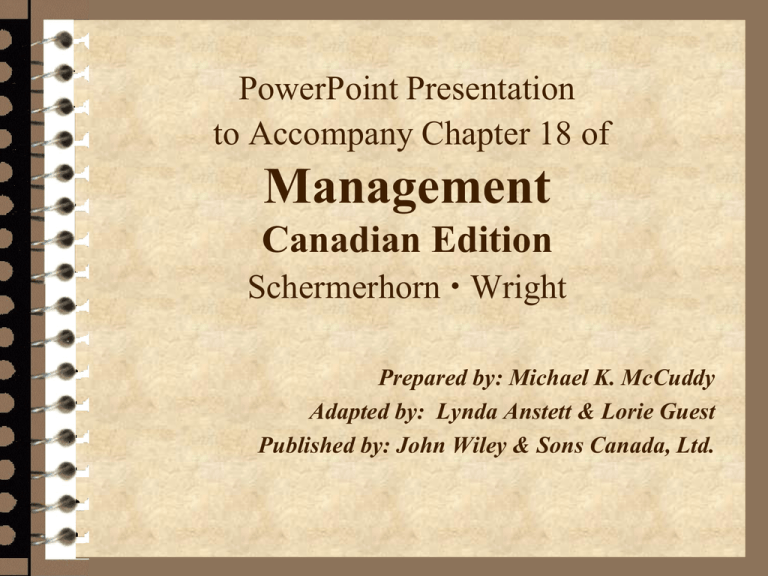
PowerPoint Presentation
to Accompany Chapter 18 of
Management
Canadian Edition
Schermerhorn Wright
Prepared by: Michael K. McCuddy
Adapted by: Lynda Anstett & Lorie Guest
Published by: John Wiley & Sons Canada, Ltd.
Planning Ahead — Chapter 18 Study Questions
What are the challenges of strategic leadership and
innovation?
What is the nature of organizational change?
How can planned organizational change be
managed?
What is organization development?
How can stress be managed in a change
environment?
Management - Chapter 18
2
Study Question 1: What are the challenges of
strategic leadership and innovation?
Strategic leadership creates the capacity for
ongoing strategic change.
Components of strategic leadership:
– Determining the organization’s purpose or vision.
– Exploiting and maintaining the organization’s core
–
–
–
–
competencies.
Developing the organization’s human capital.
Sustaining an effective organizational culture.
Emphasizing and displaying ethical practices.
Establishing balanced organizational controls.
Management - Chapter 18
3
Study Question 1: What are the challenges of
strategic leadership and innovation?
Sustainable competitive advantage relies on
creativity and innovation.
Creativity is the generation of a novel idea
or unique approach to solving problems or
crafting opportunities.
Innovation is the process of creating new
ideas and putting them into practice.
Management - Chapter 18
4
Study Question 1: What are the challenges of
strategic leadership and innovation?
Two forms of innovation:
– Process.
• Results in better ways of doing things.
– Product.
• Results in the creation of new or improved goods and services.
Innovations require invention and application.
– Invention.
• Act of discovery.
• Development of new ideas.
– Application.
• Act of use.
• Implementation of new ideas.
Management - Chapter 18
5
Study Question 1: What are the challenges of
strategic leadership and innovation?
Leadership responsibilities for the
innovation process:
– Imagining.
– Designing.
– Experimenting.
– Assessing.
– Scaling.
Management - Chapter 18
6
Study Question 1: What are the challenges of
strategic leadership and innovation?
Four steps of the product innovation
process:
– Idea creation.
– Initial experimentation.
– Feasibility determination.
– Final application.
Management - Chapter 18
7
Figure 18.1 Process of commercializing
innovation in organizations: the case of new
product development.
Management - Chapter 18
8
Study Question 1: What are the challenges of
strategic leadership and innovation?
In highly innovative organizations …
– Corporate strategy and culture should:
• Emphasize an entrepreneurial spirit.
• Expect innovation.
• Accept failure.
• Be willing to take risks.
– Organization structure should:
• Be organic.
• Have lateral communications.
• Use cross-functional teams and task forces.
Management Fundamentals: Chapter 18
9
Study Question 1: What are the challenges of
strategic leadership and innovation?
In highly innovative organizations …
– Top management should:
•
•
•
•
•
Understand the innovation process.
Be tolerant of criticism and differences of opinion.
Take all possible steps to keep goals clear.
Maintain the pressure to succeed.
Break down barriers to innovation.
– Staffing should fulfill five critical innovation roles:
•
•
•
•
•
Idea generators.
Information gatekeepers.
Product champions.
Project managers.
Innovation leaders.
Management Fundamentals: Chapter 18
10
Study Question 2: What is the nature of
organizational change?
Change leader.
– A change agent who takes leadership
responsibility for changing the existing pattern
of behavior of another person or social system.
Change leadership.
– Forward-looking.
– Proactive.
– Embraces new ideas.
Management - Chapter 18
11
Figure 18.2 Change leaders versus status
quo managers.
Management - Chapter 18
12
Study Question 2: What is the nature of
organizational change?
Top-down change.
– Strategic and comprehensive change that is
initiated with the goals of comprehensive
impact on the organization and its performance
capabilities.
– Driven by the organization’s top leadership.
– Success depends on support of middle-level
and lower-level workers.
Management - Chapter 18
13
Study Question 2: What is the nature of
organizational change?
Bottom-up change.
– The initiatives for change come from any and
all parts of the organization, not just top
management.
– Crucial for organizational innovation.
– Made possible by:
• Employee empowerment.
• Employee involvement.
• Employee participation.
Management - Chapter 18
14
Study Question 2: What is the nature of
organizational change?
Integrated change leadership.
– Successful and enduring change combines advantages
of top-down and bottom-up approaches.
– Top-down:
• Breaks up traditional patterns.
• Implements difficult economic adjustments.
– Bottom-up:
• Builds capability for sustainable change.
• Builds capability for organizational learning.
Management - Chapter 18
15
Study Question 2: What is the nature of
organizational change?
Transformational and incremental change.
– Unplanned change.
• Response to unanticipated events.
• Good leaders act on opportunities for reactive change.
– Planned change
• Aligning the organization with anticipated future challenges.
• Activated by proactive leaders who are sensitive to
performance gaps.
• Transformational change major and comprehensive
redirection.
• Incremental change adjusting existing systems and
practices.
Management - Chapter 18
16
Study Question 2: What is the nature of
organizational change?
How to lead transformational change:
– Establish a sense of urgency for change.
– Form a powerful coalition to lead the change.
– Create and communicate a change vision.
– Empower others to move change forward.
– Celebrate short-term “wins” and recognize those who
help.
– Build on success; align people and systems with new
ways.
– Stay with it; keep the message consistent; champion the
vision.
Management - Chapter 18
17
Study Question 2: What is the nature of
organizational change?
External forces for change:
–
–
–
–
–
–
–
Globalization.
Market competition.
Local economic conditions.
Government laws and regulations.
Technological developments.
Market trends.
Social forces and values.
Internal forces for change:
– Arise when change in one part of the system creates the need for
change in another part of the system.
– May be in response to one or more external forces.
Management - Chapter 18
18
Study Question 2: What is the nature of
organizational change?
Organizational targets for change:
– Tasks
– People
– Culture
– Technology
– Structure
Management - Chapter 18
19
Study Question 3: How can planned
organizational change be managed?
Phases of planned change
– Unfreezing
• The phase in which a situation is prepared for
change and felt needs for change are developed.
– Changing
• The phase in which something new takes place in
the system, and change is actually implemented.
– Refreezing
• The phase of stabilizing the change and creating the
conditions for its long-term continuity.
Management - Chapter 18
20
Figure 18.3 Lewin’s three phases of
planned organizational change.
Management - Chapter 18
21
Study Question 3: How can planned
organizational change be managed?
Force-coercion strategy of change.
– Uses power bases of legitimacy, rewards, and
punishments to induce change.
– Relies on belief that people are motivated by selfinterest.
– Direct forcing and political maneuvering.
– Produces limited and temporary results.
– Most useful in the unfreezing phase.
Management - Chapter 18
22
Study Question 3: How can planned
organizational change be managed?
Rational persuasion strategy of change.
– Bringing about change through persuasion backed by
special knowledge, empirical data, and rational
argument.
– Relies on expert power.
– Relies on belief that reason guides people’s decisions
and actions.
– Useful in the unfreezing and refreezing phases.
– Produces longer-lasting and internalized change.
Management - Chapter 18
23
Study Question 3: How can planned
organizational change be managed?
Shared power strategy of change.
– Engages people in a collaborative process of identifying
values, assumptions, and goals from which support for
change will naturally emerge.
– Time consuming but likely to yield high commitment.
– Involves others in examining sociocultural factors
related to the issue at hand.
– Relies on referent power and strong interpersonal skills
in team situations.
– Relies on belief that people respond to sociocultural
norms and expectations of others.
Management - Chapter 18
24
Figure 18.4 Alternative change strategies
and their leadership implications.
Management - Chapter 18
25
Study Question 3: How can planned
organizational change be managed?
Reasons for people resisting change:
– Fear of the unknown
– Disrupted habits
– Loss of confidence
– Loss of control
– Poor timing
– Work overload
– Loss of face
– Lack of purpose
Management - Chapter 18
26
Study Question 3: How can planned
organizational change be managed?
Methods for dealing with resistance to
change:
–
–
–
–
–
–
Education and communication
Participation and involvement
Facilitation and support
Facilitation and agreement
Manipulation and co-optation
Explicit and implicit coercion
Management - Chapter 18
27
Study Question 4: What is organization
development?
Organization development (OD) is a
comprehensive approach to planned
organizational change that involves the
application of behavioral science in a
systematic and long-range effort to improve
organizational effectiveness.
Management - Chapter 18
28
Study Question 4: What is organization
development?
Organization development goals:
– Outcome goals focus on task accomplishments.
– Process goals focus on the way people work together.
– OD seeks to develop the organization members’
capacity for self-renewal.
– OD is committed to change through freedom of
choice, shared power, and self-reliance.
– OD takes advantage of knowledge about human
behavior in organizations.
Management - Chapter 18
29
Study Question 4: What is organization
development?
The organization development process:
– Establish a working relationship.
– Diagnosis.
– Intervention.
– Evaluation.
– Achieve a terminal relationship.
Management - Chapter 18
30
Figure 18.5 Organization development
and the planned change process.
Management - Chapter 18
31
Study Question 4: What is organization
development?
Action research
– The process of systematically collecting data on
an organization, feeding it back to the members
for action planning, and evaluating results by
collecting more data and repeating the process
as necessary.
– Is initiated when someone senses a performance
gap.
Management - Chapter 18
32
Study Question 4: What is organization
development?
Steps in the action research process:
– Problem sensing.
– Data gathering.
– Data analysis and feedback.
– Action planning.
– Action implementation.
– Evaluation and follow-up.
Management - Chapter 18
33
Figure 18.6 Action research as a
foundation of organization development.
Management - Chapter 18
34
Study Question 4: What is organization
development?
Individual OD interventions
– Sensitivity training (T-groups)
– Management training
– Role negotiation
– Job redesign
– Career planning
Management - Chapter 18
35
Study Question 4: What is organization
development?
Team OD interventions
– Team building
– Process consultation
– Inter-group team building
Management - Chapter 18
36
Study Question 4: What is organization
development?
Organization-wide OD interventions
– Survey feedback
– Confrontation meeting
– Structural redesign
– Management by objectives (MBO)
Management - Chapter 18
37
Study Question 5: How can stress be managed
in a change environment?
Stress
– A state of tension experienced by individuals facing
extraordinary demands, constraints, or opportunities.
Stressors
– Things that cause stress
– Originate in work, personal, and nonwork situations.
– Have the potential to influence work attitudes,
behavior, job performance, and health.
Management - Chapter 18
38
Study Question 5: How can stress be managed
in a change environment?
Work factors as potential stressors:
– Includes:
•
•
•
•
Excessively high or low task demands.
Role conflicts or ambiguities.
Poor interpersonal relationships.
Too slow or too fast career progress.
– Work-related stress syndromes:
• Set up to fail.
• Mistaken identity.
Management - Chapter 18
39
Study Question 5: How can stress be managed
in a change environment?
Personal factors as potential stressors:
– Includes needs, capabilities, and personality.
– Stressful behavior patterns of the Type A personality:
•
•
•
•
•
•
•
Always moving, walking, and eating rapidly.
Acting impatient, hurrying others, disliking waiting.
Doing, or trying to do, several things at once.
Feeling guilty when relaxing.
Trying to schedule more in less time.
Using nervous gestures such as a clenched fist.
Hurrying or interrupting the speech of others.
Management - Chapter 18
40
Study Question 5: How can stress be managed
in a change environment?
Nonwork factors as potential stressors:
– Includes:
• Family events.
• Economics.
• Personal affairs.
– “Spill-over” effect on the stress an individual
experiences at work.
Management - Chapter 18
41
Study Question 5: How can stress be managed
in a change environment?
Consequences of stress:
– Constructive stress.
• Acts as a positive influence.
• Can be energizing and performance enhancing.
– Destructive stress.
• Acts as a negative influence.
• Breaks down a person’s physical and mental
systems.
• Can lead to job burnout and/or workplace rage.
Management - Chapter 18
42
Figure 18.7 Potential negative
consequences of a destructive job stressburnout cycle.
Management - Chapter 18
43
Study Question 5: How can stress be managed
in a change environment?
Personal wellness:
– The pursuit of personal and mental potential
though a personal health-promotion program.
– A form of preventative stress management.
– Enables people to be better prepared to deal
with stress.
Management - Chapter 18
44
COPYRIGHT
Copyright © 2007 John Wiley & Sons Canada, Ltd. All rights
reserved. Reproduction or translation of this work beyond that
permitted by Access Copyright (The Canadian Copyright Licensing
Agency) is unlawful. Requests for further information should be
addressed to the Permissions Department, John Wiley & Sons
Canada, Ltd. The purchaser may make back-up copies for his or her
own use only and not for distribution or resale. The author and the
publisher assume no responsibility for errors, omissions, or damages
caused by the use of these programs or from the use of the
information contained herein.

